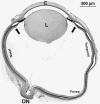Development of Retinal Layers in Prenatal Human Retina
- PMID: 26410132
- PMCID: PMC5538359
- DOI: 10.1016/j.ajo.2015.09.023
Development of Retinal Layers in Prenatal Human Retina
Abstract
Purpose: To determine the developmental sequence of retinal layers to provide information on where in utero pathologic events might affect retinal development.
Design: Qualitative and quantitative descriptive research.
Methods: A histology collection of human eyes from fetal week (Fwk) 8 to postnatal (P) 10 weeks was analyzed. The length of the nasal and temporal retina was measured along the horizontal meridian in 20 eyes. The location of the inner plexiform layer (IPL) and outer plexiform layer (OPL) was identified at each age, and its length measured.
Results: The human eye retinal length increased from 5.19 mm at Fwk 8 to 20.92 mm at midgestation to 32.88 mm just after birth. The IPL appeared in the presumptive fovea at Fwk 8, reached the eccentricity of the optic nerve by Fwk 12, and was present to both nasal and temporal peripheral edges by Fwk 18-21. By contrast, the OPL developed slowly. A short OPL was first present in the Fwk 11 fovea and did not reach the eccentricity of the optic nerve until midgestation. The OPL reached the retinal edges by Fwk 30. Laminar development of both IPL and OPL occurred before vascular formation.
Conclusions: In human fetal retina, the IPL reached the far peripheral edge of the retina by midgestation and the OPL by late gestation. Only very early in utero events could affect IPL lamination in the central retina, but events occurring after Fwk 20 in the peripheral retina would overlap OPL laminar development in outer retina.
Copyright © 2016 Elsevier Inc. All rights reserved.
Figures




Similar articles
-
Histologic development of the human fovea from midgestation to maturity.Am J Ophthalmol. 2012 Nov;154(5):767-778.e2. doi: 10.1016/j.ajo.2012.05.007. Epub 2012 Aug 28. Am J Ophthalmol. 2012. PMID: 22935600 Free PMC article.
-
Expression of photoreceptor-associated molecules during human fetal eye development.Mol Vis. 2003 Aug 28;9:401-9. Mol Vis. 2003. PMID: 12949469
-
Development of the human retina in the absence of ganglion cells.Exp Eye Res. 2006 Oct;83(4):920-31. doi: 10.1016/j.exer.2006.04.017. Epub 2006 Jun 21. Exp Eye Res. 2006. PMID: 16793038
-
Spatial and temporal expression of short, long/medium, or both opsins in human fetal cones.J Comp Neurol. 2000 Oct 2;425(4):545-59. J Comp Neurol. 2000. PMID: 10975879
-
Synaptic development in macaque monkey retina and its implications for other developmental sequences.Perspect Dev Neurobiol. 1996;3(3):195-201. Perspect Dev Neurobiol. 1996. PMID: 8931093 Review.
Cited by
-
Electrophysiologic Characterization of Developing Human Embryonic Stem Cell-Derived Photoreceptor Precursors.Invest Ophthalmol Vis Sci. 2020 Sep 1;61(11):44. doi: 10.1167/iovs.61.11.44. Invest Ophthalmol Vis Sci. 2020. PMID: 32991686 Free PMC article.
-
Localization of fluorescent gold nanoparticles throughout the eye after topical administration.Front Med (Lausanne). 2025 Mar 19;12:1557611. doi: 10.3389/fmed.2025.1557611. eCollection 2025. Front Med (Lausanne). 2025. PMID: 40177275 Free PMC article.
-
Comparison of Developmental Dynamics in Human Fetal Retina and Human Pluripotent Stem Cell-Derived Retinal Tissue.Stem Cells Dev. 2021 Apr;30(8):399-417. doi: 10.1089/scd.2020.0085. Stem Cells Dev. 2021. PMID: 33677999 Free PMC article.
-
Development of ON and OFF cholinergic amacrine cells in the human fetal retina.J Comp Neurol. 2019 Jan 1;527(1):174-186. doi: 10.1002/cne.24405. Epub 2018 Feb 25. J Comp Neurol. 2019. PMID: 29405294 Free PMC article.
-
Molecular Anatomy of the Developing Human Retina.Dev Cell. 2017 Dec 18;43(6):763-779.e4. doi: 10.1016/j.devcel.2017.10.029. Epub 2017 Dec 7. Dev Cell. 2017. PMID: 29233477 Free PMC article.
References
-
- Mann I. The Development of the Human Eye. 3rd. New York: Grune & Stratton; 1964.
-
- Yuodelis C, Hendrickson A. A qualitative and quantitative analysis of the human fovea during development. Vision Res. 1986;26(6):847–855. - PubMed
-
- Xiao M, Hendrickson A. Spatial and temporal expression of short, long/medium or both opsins in human fetal cones. J Comp Neurol. 2000;425:545–559. - PubMed
Publication types
MeSH terms
Grants and funding
LinkOut - more resources
Full Text Sources
Other Literature Sources
Medical

